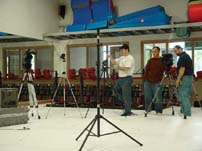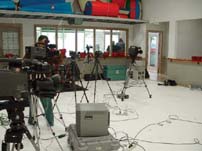Hack 36. Freeze Time
| < Day Day Up > |
|
Roll your own "bullet time," a la The Matrix. Some time ago, I discovered how to make my own version of the popular bullet-time effect seen in The Matrix. What I'll call freeze time is visual effect known by several names (detailed later in this hack), in which some, presumably dramatic, action comes to a halt while the camera shooting the action appears to move through space. The effect has been around for over 20 years, but it was recently made very popular by The Matrix and its sequels. 3.12.1. Discovering the PastI'm quite amused by this whole concept and method, since it has been considered so "revolutionary" for the last several years. Why am I amused? Well, the very first motion picture was shot over 100 years ago, using an array of still cameras set along a racehorse track, connected to trip wires. Each camera took a photo in turn as a horse ran past the trip wires. Lore has it that the rig was set up to settle a bet about whether a horse ever has all four feet off the ground when running (turns out it does). The side effect, when flipping through all the photos in succession, was a moving picture of a horse running. Now, almost the same rig is being used a full century later, to make motion stop! 3.12.1.1. Designing the first solutionAccording to an article in Videomaker magazine (June 2001; "Magic Morphing" by Scott Anderson), the first example of bullet time was in 1980 by an art student named Tim Macmillian. He was busy making collages of photos taken at several angles, usually random, at the same instant. As he progressed to adding more and more cameras per shot, he got to a point where he wanted more cameras than he could afford, so he built one to suit his special need. This camera was just a big, long piece of wood with a slot, a window, a strip of film, and a shutter with lots of individual round holes. By tripping the shutter, the entire strip of film would be exposed through the holes. The result: when quickly flipping through the images, the action remained frozen, but it would appear that a single camera was in motion rather than several cameras sitting still. 3.12.1.2. Using hardware and softwareFast-forward several years and along comes The Matrix, and special effects guru John Gaeta, to refine this effect to new levels. For The Matrix, Gaeta pioneered the concept of computer-controlled still cameras that shot a fraction of a second after one another to create both a camera sweep and a slow progression of time rather than a frozen moment. He also made extensive use of interpolation software to smooth the transition from one photo to the next and shot the subject in a green screen room to be composited into a CGI environment.
So, what exactly is this effect called? Tim Macmillan called it time slice. Manes Studios (a.k.a. The Matrix guys) called it flow-mo, but Gaeta called it bullet time. The effect is also called temps mort (dead time), timetrack, virtual camera, multicam, and (viewers of the Super Bowl) EyeVision. Whatever you call it, I think it's a great effect. 3.12.2. Approximating the EffectHere's how you can approximate this effect with some friends and a six video camera setup. 3.12.2.1. Setting up for the shootFor the shoot, you should collect six video cameras and set pair of them at the 90-degree points. If all else fails, you'll at least have good video from these two angles. Between the two cameras, fill out the arc with the other four cameras. You should place a light stand at the focal point of the arc. This will be your target point. Then use a string, with a bubble level on it, to measure out a common distance and height for the front/center for all of the camera lenses. The measurement will ensure that all of your cameras are the same distance and height from the target point. Figures 3-28 and 3-29 show the initial setup. To calibrate pan, tilt, and focal length, you need to connect the first camera to a video monitor [Hack #11] and aim it at the light stand. Then mark the screen position of the target point on the tripod directly onto the monitor with a dry-erase marker. Finally, connect each of the remaining cameras, in turn, to the same monitor and adjust them to position the target point directly behind the marker spots on the monitor glass. Figure 3-30 shows a cameraman adjusting one camera while using an external monitor for reference. You should do your best to eyeball the entirety of the scene, with the expectation that any necessary corrections can be done in post-production. Figure 3-28. Placing the main cameras on the outside of the arc Figure 3-29. Measuring the distance to each camera, an important step 3.12.2.2. Capturing the sceneWith all the cameras running, either slate your shot [Hack #9] or fire an still-camera flash just prior to each event, in order to mark the same instant in time on all the tapes. From this marker, it will be easy to identify the starting frame on all cameras. You should then be able to step forward to a frame during the event while editing, and jump to the same event instantly on any camera. 3.12.2.3. Finishing the sceneYou can finish the shot using practically any video editing application. You should use a paint tool, or other frame of reference, to capture the synchronized still frame needed from each camera. From there, you can use the timeline to make a template that properly aligns and matches-up the six cameras. The template can then be used to create as many different shots as you want. Figure 3-30. Adjusting a camera using an external monitor You can see how the effect turns out at http://www.hiddenphantom.com/NBBF/PalmHeel.wmv (Windows Media Player 9 or higher, or VLC, required). Nick Jushchyshyn |
| < Day Day Up > |
EAN: 2147483647
Pages: 158
